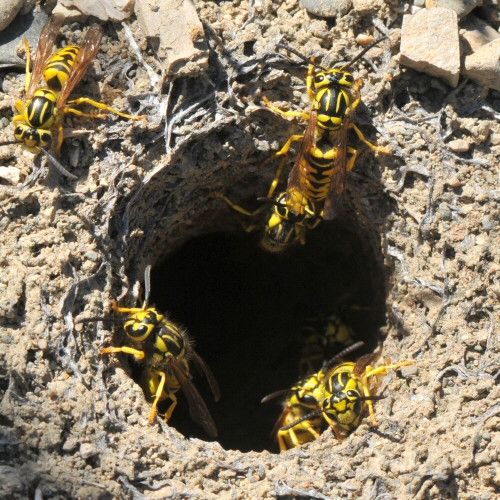
What to Do About Wasps
As summer temperatures increase, so do the number of wasps around homes and yards. One of the most common wasp groups is the Family Vepidae, which includes yellow jackets, hornets, paper and mud wasps. There are about 325 species of vespids in North America that build nests from wood fibers, leaves and mud. Most are black or reddish brown with yellow or white markings.
Some are social with queens, workers and males, such as the bald-faced hornet that builds large, round paper nests in trees and the yellow jacket that builds enclosed paper nests, mostly in the ground. Female workers protect their nests from intruders with painful stings. Unlike honey bee workers that leave the stinger in the victim, these wasps can inflict multiple stings.
The mason and potter wasps attach their mud nests to a flat surface such as a wall, or they hide them in logs or the ground. Each female builds her own nest and feeds her own young. These solitary wasps can also sting, but the intensity of the sting tends to be much less than that of a social wasp since they are only defending their own nest and not an entire colony.
Paper wasps are some of the most common wasps in urban areas. In Utah, there are native species that have slender reddish brown bodies with yellow markings and brown wings. They build circular open-celled nests that hang from a slender stalk and live in small colonies of females that share the work of feeding the young, so they are semi-social.
Another common paper wasp in Utah is the invasive European paper wasp. It has a slender yellow and black body, and like the native species, it builds umbrella-shaped nests under eaves, in outbuildings, in pipe openings and under other protected structures.
When they arrived in Utah about a decade ago, European paper wasp populations overwhelmed the native paper wasps. In recent years it appears that populations are more in balance with the native species, but they have adapted well to Utah conditions and seem to be here to stay. The native and European paper wasps will also sting to defend their nest or if trapped against the skin. The intensity of their stings tends to be between that of the social and solitary wasps and is moderately painful.
It is important to note that paper wasps and their relatives do provide benefits to humans. They eat insects and other arthropods and feed an insect-based diet to their young. Their predation on caterpillars and beetle and leafminer larvae can help reduce these pests in the garden. Some species will scavenge on dead insects and spiders. Many also feed on nectar and pollen and can contribute to the pollination of plants.
Downsides, in addition to painful stings, include the propensity of yellow jackets to steal bits of meat and other food from cookouts. European paper wasps can be a major pest of fruit crops. They can feed heavily on soft, ripe fruits such as raspberries, blackberries, peaches and cherries. They switch to fruit-oriented feeding behavior in mid-to-late summer when ripe fruits become abundant and to satisfy their energy needs.
Treat their nests with an insecticide, such as permethrin, in the early morning before temperatures rise and adults leave the nest. Purchase a wasp insecticide in a can with a straw-like applicator. Wear protective clothing and glasses or safety goggles. Soak the nest with the insecticide to kill the adults and larvae in the chambers. Leave the nest for at least 24 hours, then return to completely remove them. Paper wasps put their own chemicals on their nests to attract other females to build nests in the same location. Place fruit-juice baited traps for the European paper wasp around the yard and garden in mid and late summer. To make a homemade pop bottle trap, cut off the top at the “shoulders” of the bottle, turn it over and insert the top into the bottom to form a funnel. Punch holes near the top and add a wire for hanging the trap. Bait traps with 1 part fruit juice to 10 parts water, 1 teaspoon yeast, a piece of ripe fruit and several drops of liquid detergent. Place the traps about every 30 feet around the perimeter of fruit crops. Empty and refresh the bait every 2 weeks. To view a video on how to build a homemade European paper wasp trap, go to Yellow jackets are attracted to different odors than the European paper wasp. Commercial traps are available that contain heptyl butyrate, an effective yellow jacket bait. You can also make a homemade pop bottle trap and bait it with a chunk of meat, however it will begin to smell when the meat rots. Place yellow jacket traps in the yard 20 to 30 feet away from the patio, doorways or other areas with high human activity. Look for ground sites with high yellow jacket activity, usually near shrubbery, rock piles, block and stone walls and other protected sites. If necessary, nests can be treated with insecticides and removed, or a professional can be hired for the job. Eliminate puddles of water and leaking faucets in areas with high wasp activity. Note, however, that sources of water and mud are important for beneficial wasps, such as mud daubers, pollinating insects and insects that are predators of pest insects


